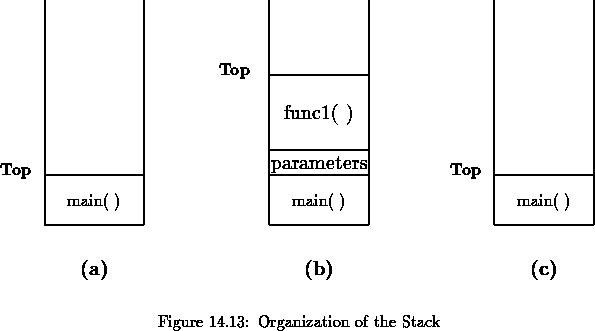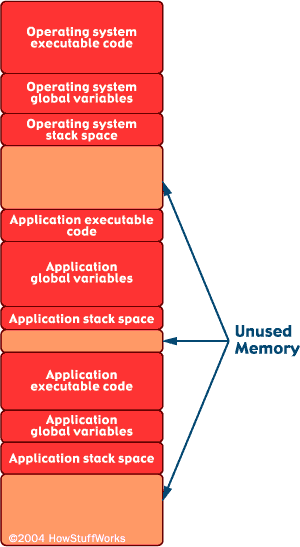來自:http://www.tkk7.com/cjren/archive/2007/12/25/56989.html
Stack vs Heap Allocation
How the memory of the computer is organized for a running program? When a program is loaded into memory, it is organized into three areas of memory, called segments: the text segment, stack segment, and heap segment. The text segment (sometimes also called the code segment) is where the compiled code of the program itself resides. This is the machine language representation of the program steps to be carried out, including all functions making up the program, both user defined and system.
The remaining two areas of system memory is where storage may be allocated by the compiler for data storage. The stack is where memory is allocated for automatic variables within functions. A stack is a Last In First Out (LIFO) storage device where new storage is allocated and deallocated at only one ``end'', called the Top of the stack. This can be seen in Figure 14.13.?
 When a program begins executing in the function main(), space is allocated on the stack for all variables declared within main(), as seen in Figure 14.13(a). If main() calls a function, func1(), additional storage is allocated for the variables in func1() at the top of the stack as shown in Figure 14.13(b). Notice that the parameters passed by main() to func1() are also stored on the stack. If func1() were to call any additional functions, storage would be allocated at the new Top of stack as seen in the figure. When func1() returns, storage for its local variables is deallocated, and the Top of the stack returns to to position shown in Figure 14.13(c). If main() were to call another function, storage would be allocated for that function at the Top shown in the figure. As can be seen, the memory allocated in the stack area is used and reused during program execution. It should be clear that memory allocated in this area will contain garbage values left over from previous usage.
When a program begins executing in the function main(), space is allocated on the stack for all variables declared within main(), as seen in Figure 14.13(a). If main() calls a function, func1(), additional storage is allocated for the variables in func1() at the top of the stack as shown in Figure 14.13(b). Notice that the parameters passed by main() to func1() are also stored on the stack. If func1() were to call any additional functions, storage would be allocated at the new Top of stack as seen in the figure. When func1() returns, storage for its local variables is deallocated, and the Top of the stack returns to to position shown in Figure 14.13(c). If main() were to call another function, storage would be allocated for that function at the Top shown in the figure. As can be seen, the memory allocated in the stack area is used and reused during program execution. It should be clear that memory allocated in this area will contain garbage values left over from previous usage.
The heap segment provides more stable storage of data for a program; memory allocated in the heap remains in existence for the duration of a program. Therefore, global variables (storage class external), and static variables are allocated on the heap. The memory allocated in the heap area, if initialized to zero at program start, remains zero until the program makes use of it. Thus, the heap area need not contain garbage.
小結(jié):
Stack: automatic variables within functions
Heap: global variables (storage class external), and static variables
============================
In java 情況如下
(1)
?The stack is the program memory area, so all your primitive type variables and the memory adress of your objects are written on the stack. It is a fast access valuable memory area.
The heap is where the VM keeps the objects, and it is a huge amount of memory. When you create an object, the VM puts the object in the HEAP and puts the adress of the object created on the STACK.
(2)
?There are two kinds of memory used in Java. These are called stack memory and heap memory. Stack memory stores primitive types and the addresses of objects. The object values are stored in heap memory. An object reference on the stack is only an address that refers to the place in heap memory where that object is kept.
?It is useful to know that these two different kinds of memory exist in Java. Stack memory is the program's memory, and heap memory resides outside of the program.這好像有點跟C的不同(相反)。
引入一點垃圾回收機(jī)制的知識
?When you need a new object, Java allocates the required memory. When you are done with an object, the memory is reclaimed for you automatically via Java's garbage collection facility.
?Garbage collection runs as a thread in the background, looking for objects that no longer have a usable reference. When it finds them, it destroys them and reclaims the memory.
?The implementation of garbage collection varies between Java Virtual Machines. They generally follow the same process, however. First, the garbage collector gets a snapshot of all running threads and all loaded classes. Then, all objects that are referred to by this thread set are marked as current. The process stops when all objects that it is possible to reach have been marked and the rest have been discarded.
?In order to help the Virtual Machine, it is a good idea to remove your references to unneeded objects. This is often done by simply setting your reference to null:
?Test t = new Test();
?t.someAction();
?// all done
?t = null;
小結(jié):
Stack: Primitive data types(primitive types), the addresses of objects(=references).
Heap:? objects.
===============================================
從系統(tǒng)的角度看 stack(棧)和heap(堆)
Dynamic Data Structures: The Heap
A typical personal computer or workstation today has somewhere between 16 and 64 megabytes of RAM installed. Using a technique called virtual memory, the system can swap pieces of memory on and off the machine's hard disk to create an illusion for the CPU that it has much more memory, for example 200 to 500 megabytes. While this illusion is complete as far as the CPU is concerned, it can sometimes slow things down tremendously from the user's perspective. Despite this drawback, virtual memory is an extremely useful technique for "increasing" the amount of RAM in a machine in an inexpensive way. Let's assume for the sake of this discussion that a typical computer has a total memory space of, for example, 50 megabytes (regardless of whether that memory is implemented in real RAM or in virtual memory).
The operating system on the machine is in charge of the 50-megabyte memory space. The operating system uses the space in several different ways, as shown here:

The operating system and several applications, along with their global variables and stack spaces, all consume portions of memory. When a program completes execution, it releases its memory for reuse by other programs. Note that part of the memory space remains unused at any given time.
This is, of course, an idealization, but the basic principles are correct. As you can see, memory holds the executable code for the different applications currently running on the machine, along with the executable code for the operating system itself. Each application has certain global variables associated with it. These variables also consume memory. Finally, each application uses an area of memory called the stack, which holds all local variables and parameters used by any function. The stack also remembers the order in which functions are called so that function returns occur correctly. Each time a function is called, its local variables and parameters are "pushed onto" the stack. When the function returns, these locals and parameters are "popped." Because of this, the size of a program's stack fluctuates constantly as the program is running, but it has some maximum size.
As a program finishes execution, the operating system unloads it, its globals and its stack space from memory. A new program can make use of that space at a later time. In this way, the memory in a computer system is constantly "recycled" and reused by programs as they execute and complete.
In general, perhaps 50 percent of the computer's total memory space might be unused at any given moment. The operating system owns and manages the unused memory, and it is collectively known as the heap. The heap is extremely important because it is available for use by applications during execution using the C functions malloc (memory allocate) and free. The heap allows programs to allocate memory exactly when they need it during the execution of a program, rather than pre-allocating it with a specifically-sized array declaration.